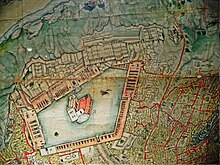Bahu Fort Jammu
Bahu Fort
The earliest historical recorded link to the fort is that of Raja Jambu Lochan and his brother Bahu Lochan, sons of a powerful ruler Agnigarbha II of the Jammu dynasty of Suryavanshi kings. Bahu, the eldest of Agnigarbha's 18 sons, is credited with establishing the Jammu city and building the fort. The earlier fort structure was modified over the years to a stronger fortified structure. The present fort was rebuilt, probably at the same location as the ancient fort, by Autar Dev, the grandson of King Kapoor Dev in 1585. Over the years the fort underwent demolitions and reconstructions from time to time, until during Sikh Empire the then new Governor/Raja of Jammu Maharaja Gulab Singh reconstructed the present fort in the 19th century, which was further refurbished during the rule of Maharaja Ranbir Singh. They first established temples for their tutelary deities; the image of Mahakali deity in the temple in the fort was brought from Ayodhya.
Structures
The fort structure is located at an elevation of 325 metres (1,066 ft), opposite to the old town of Jammu. The fortified structure has thick walls made of sandstones built with lime and brick mortar.[clarification needed] It has eight octagonal towers or turrets connected by thick walls. The towers have enclosures to house guards. The main entry is fit to allow passage of elephants into the fort. A water tank with access for pilgrims to take bath is located on the left entry into the fort. This tank or pond is 6.1×6.1 metres (20 ft) in size and has a water depth of 4.6 metres (15 ft). A pyramidal structure is on the right flank (with very thick walls to withstand any gun attack) of the fort was an ammunition store. An underground chamber here was used a prison. This chamber has a secret exit to escape from the fort in case of any emergencies. The first floor is lavishly built with arches and decorated with floral designs like a Baradari or a palace.
To the right of the temple, there are a few halls which were used in the past as assembly halls and offices of the Quiledar (master of the fort). However, they are not maintained at all. The royal stables were also located within this fort. Substantial renovation and additions to attract visitors have been added during recent years.Mahakali temple
It is a renowned Shakti temple built within the fort during the 8th century. It has been built in white marble on a raised platform of 1.2 metres (3.9 ft) height. While it is claimed that it was built during 8th or 9th century, the temple as built looks modern. It is a small temple which can accommodate only a few worshippers at a time at the Mandapa, outside the sanctum sanctorum. In the past, animal sacrifice was practiced at this temple, which has since been discontinued. Today, a priest performs a few rites uttering some religious incantations and sprinkles holy water over the animal (usually a sheep or goat) and then lets it go free. Other food offering made by devotees is a sweet dish called Kadah (pudding), after their wishes placed before the deity are fulfilled.
Another special feature seen in the temple precincts is the presence of a large group of Rhesus monkeys, the largest such group in Jammu and Kashmir State. The monkeys are fed by devotees with sweets, gram etc.
Aquarium
The Aquarium near Bahu Fort is a new edition to the garden. The fish-shaped aquarium is the largest underground aquarium in the country and hosts an impressive collection of fish. The aquarium is 22m in length and exhibits around 400 species of fish. It also has a small museum attached to the end of the aquarium.










Comments